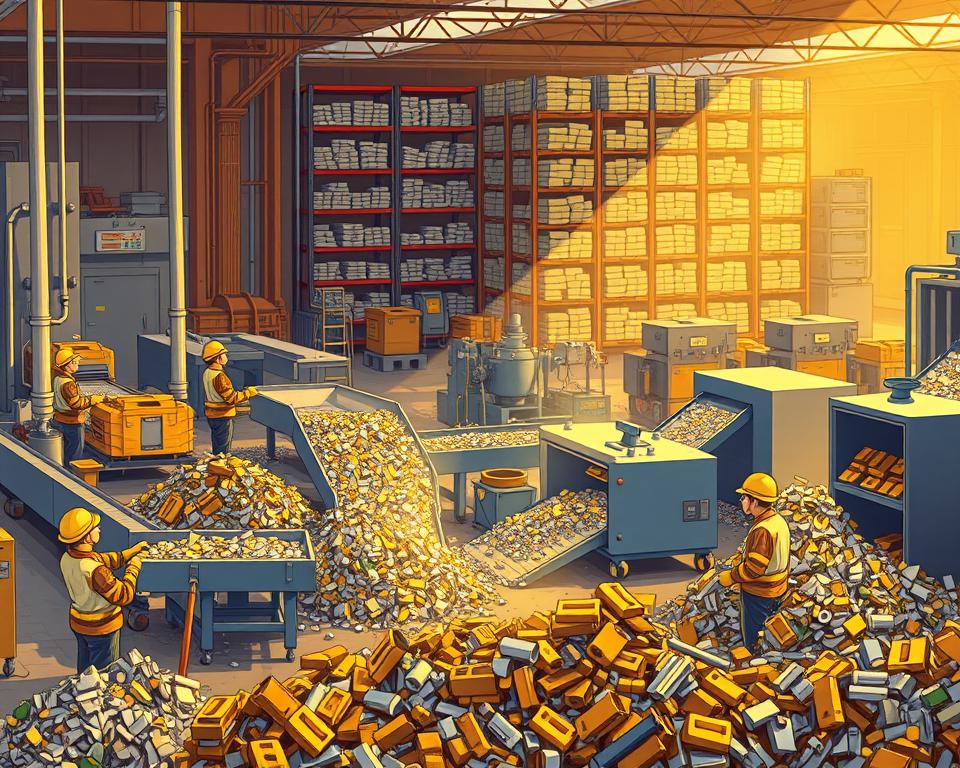Sustainable Precious Metal Recovery Guide
Did you know that more than $60 billion worth of precious metals are discarded each year in electronic waste alone? Such a massive amount highlights why precious metal recycling is so vital. It’s not just good for our economy but also for the environment. By recycling metals like gold, silver, platinum, and palladium, we cut down on pollution and save natural resources.
Leaders such as Dongsheng Metal Trading are paving the way for sustainable recycling. They make sure those precious metals get reused rather than landfilled. Such a precious metals recycling companies model drives eco-friendly recycling and sustainable methods.
Essential Summaries
- More than $60 billion of precious metals end up in e-waste each year.
- Recovering these metals cuts eco-impact and preserves resources.
- Gold, silver, platinum, and palladium top the list of valuable metals.
- Green recycling methods are essential for a sustainable future.
- Firms such as Dongsheng Metal Trading focus on precious metal recovery.
Exploring Precious Metals and Their Worth
Naturally scarce metallic elements called precious metals draw interest from industries and investors. Gold, silver, platinum, and palladium are prime examples, known for their unique properties. These include electrical conductivity, corrosion resistance, and substantial rarity. Extracting and refining them uses up huge resources, so recycling becomes critical.

Intrinsic qualities and demand in the marketplace determine precious metals’ worth. Recycling precious metals plays a critical role in sustaining the supply chain. It lowers the ecological damage from mining. Advanced recycling can bring metals back to their initial quality. Such efforts save limited resources and create economic gains.
What are Precious Metals?
These metals’ special traits lend themselves to diverse applications. Economic value stems from their scarcity and innate qualities. For example:
- Gold: Prized for its shine and tarnish-proof nature.
- Ag: Celebrated for its adaptability and conductivity.
- Platinum: Celebrated for its durability and catalytic properties.
- Pd: Increasingly popular in automotive and electronic applications.
Why Recycle Precious Metals?
The practice of recycling precious metals has emerged as a vital component for sustainability. It saves scarce materials and sharply cuts mining’s eco-footprint. Consider these advantages:
- Lessening of habitat destruction from mining.
- Energy needs are far lower than mining virgin ore.
- Contribution to a circular economy by reintroducing materials into production cycles.
- Opportunity for profit by recovering valuable metals.
Why Precious Metal Recycling Matters
Metal recycling brings both green and economic gains. Pointing out these perks shows how to shrink our eco-impact. Plus, it spurs economic development and steadiness.
Environmental Benefits
The environmental benefits of recycling precious metals are significant. By reclaiming metals from discarded electronics and industrial scrap, we cut down on landfill waste. That cuts new mining needs and saves resources.
It lessens mining impacts, including ecosystem harm and contaminants. Focusing on recycling precious metals helps us strive for a more sustainable future.
Financial Gains
The economic benefits of recycling are equally compelling. Recovering metals cuts production expenses. It lets businesses choose reclaimed over freshly mined metals.
This shift creates jobs in recycling facilities and boosts market stability as demand for recycled metals grows. Using these financial benefits, companies can improve profits. They further support a cleaner economy.
The Precious Metal Recycling Process
The precious metal recycling process is complex, involving several stages to ensure maximum efficiency. It starts with collecting metals from various sources like discarded electronics, jewelry, and industrial scraps. Next comes sorting, cleaning, and testing to assess metal content and worth.
Recovery Steps
A structured workflow is key to high-yield recovery. Every phase aims to maximize precious-metal returns. Sorting separates metals by type and purity. Cleaning strips away impurities that impede extraction. Chemical analysis pinpoints metal levels to drive technique decisions.
Metal Separation Techniques
Cutting-edge processes boost precious-metal recovery. Thermal reduction applies intense heat to isolate metals. Smelting and chemical baths extract and purify metals. Companies like Dongsheng Metal Trading use these methods to boost efficiency and maximize returns in the precious metal recycling process.
Recyclable Precious Metals
Recycling is vital for the environment and for recovering valuable materials. Numerous precious metals lend themselves to recycling, serving both business and environment. Knowing which metals are recyclable helps individuals and firms.
Recycling Gold, Silver & Platinum
Gold, silver, and platinum are well-known precious metals. You’ll see them in rings, currency, and industrial parts. Gold’s high price and use make it a prime recycling target. Silver recycling is also key, used in photography, electronics, and solar panels.
Though scarcer, platinum’s worth shines in auto catalysts.
E-Waste Metals
Electronics scrap contains metals ripe for recovery. Devices such as phones and computers hold palladium and indium. Reclaiming them cuts e-waste and recovers key resources.
Recycling these electronics metals is imperative. Industries aim to minimize waste and efficiently recycle resources.
Who Gains from Metal Recycling?
Metal recovery underpins major sectors by supplying reclaimed resources sustainably. Device manufacturing in electronics profits hugely from recovered metals. Aerospace and medical sectors also depend on these metals for critical components. Looking at their recycling practices shows green and financial gains.
Electronics Industry
Because devices abound with metals, electronics tops recycling efforts. Rapid technological advancements have led to a significant increase in electronic waste. Thus, recycling gold, silver, and palladium efficiently becomes vital. That saves resources and cuts mining carbon footprints.
Firms ramp up recycling to hit sustainability targets. Such a move upholds efforts to conserve and protect.
Aerospace & Medical
Aerospace metal recycling is vital for the aerospace and medical industries, which rely on precious metals for critical components. Alloys prized for strength and anti-corrosion make up flight and medical components. Recycling these metals can significantly lower material costs and comply with environmental regulations.
They recognize that recycling offsets material scarcity. It also enhances operational efficiency, making recycling a key strategy for sustainability.
Selecting Recycling Partners
Choosing reputable metal recyclers is vital for success. It’s wise to ask important questions to understand their operations. Their fees and techniques will shape your outcome. Service comparisons help you pick the best recycler.
Questions to Ask Recycling Companies
- Can you share your precious-metal recovery accreditations?
- What techniques do you use for each metal type?
- Which recovery percentages do you achieve for each metal?
- What is your pricing structure and are there extra charges?
- Can you provide references or testimonials from previous clients?
Evaluating Offers
When searching for a recycler, it’s vital to compare different companies based on their services. Create a table to compare key factors such as:
| Company Name | Recovery Rate (%) | Processing Fee ($) | Turnaround Time (Days) |
|---|---|---|---|
| Recycling Co. A | 95 | 50 | 7 |
| Recycling Co. B | 90 | 45 | 5 |
| Recycling Co. C | 92 | 55 | 10 |
By comparing recycling services, you can find the best recycler for your needs. That way, you maximize returns and maintain quality.
Recycling Precious Metals: A Green Guide
Understanding how recyclers operate is key for those interested in precious metal recycling. They handle all stages, from gathering to final refining. This ensures maximum efficiency and value from metals.
Behind the Scenes of Recycling
They apply high-tech processes—testing, sorting, refining—to recover metals. Collection comes from devices, jewelry, and industrial waste. Then, they use sophisticated techniques to separate different metals. In the last stage, precious metals are refined to purity.
This process not only maximizes resource recovery but also supports eco-friendly practices. It’s essential for long-term sustainability.
Selecting Your Ideal Recycler
You’ll want to weigh several factors in your choice. Start with their sustainability track record. A focus on sustainability is non-negotiable. Also, examine if they handle everything or only certain stages.
Pricing is another key factor. Get quotes to compare different options. Companies like Dongsheng Metal Trading offer customized solutions for various industries. They stand out as dependable recyclers.
Pick the Right Facility
Metal recycling is a critical sector for sustainable practices and waste management. It encompasses various recycling centers, each tailored to specific metal recovery needs. Understanding these facilities improves access to recyclers and their services. It aids companies and conserves nature.
Recycling Center Types
Facilities differ greatly in their focus and processes. Certain centers specialize in high-value metals; others take general scrap. Common examples include:
- Scrap yards process a broad mix of metal types.
- Precious Metal Recovery Companies: With a focus on high-value materials such as gold, silver, and platinum, these companies offer refined processing techniques.
- Electronics recyclers extract metals from old gadgets.
Facility Access Factors
Accessibility to recyclers is key for efficient metal recovery. Companies should evaluate haulage considerations. Here are some factors that influence access:
| Factor | Description |
|---|---|
| Proximity | Nearby recyclers reduce haul time and expense. |
| Networking | Strong ties with local centers streamline recovery. |
| Services Offered | Awareness of service menus aids in picking the right center. |
Ultimately, facility type and access shape recycling success.
Recovering Metals from E-Waste
Discarded electronics threaten the environment. Many e-waste items hold recoverable precious metals. It shows why we should treat e-waste as treasure.
How Electronics Contain Precious Metals
Gadgets harbor small quantities of precious metals. These metals are found in various parts:
- Circuit boards
- Connectors and ports
- Capacitors and resistors
- Battery terminals
Even everyday items like smartphones, laptops, and TVs are filled with these metals. Recycling lets us reclaim and repurpose those metals.
E-Waste Recovery Benefits
E-waste recycling is vital for both environmental protection and resource recovery. That cuts landfill volume and conserves resources. The benefits of recycling e-waste metals are clear:
- It cuts ecological hazards from poor e-waste handling
- It cuts down on carbon emissions through eco-friendly practices
- It supports the circular economy by recycling materials back into production
Promoting e-waste recovery advances resource stewardship. It lays the groundwork for a greener future.
Future Trends in Metal Recovery
Metal recycling is evolving, spurred by tech advances and green initiatives. Facing resource limits, recyclers embrace new methods. Adopting fresh techniques, they’re shaping tomorrow’s recycling.
Eco-Friendly Recycling Innovations
Modern green recycling strives to cut waste and eco-damage. Companies are shifting towards eco-friendly practices, like using biodegradable packaging and energy-efficient processes. That evolution supports global green targets and fosters industry responsibility.
Cutting-Edge Recovery Methods
New methods in recovery enhance recycling performance. Automated sorters and hydrometallurgy ramp up yield. They ramp up yields and shrink eco-footprints, advancing metal recycling.
Starting a Precious Metal Recycling Venture
Launching a metal recovery firm requires careful strategy and market insight. Leaders should map out steps, secure compliance, and set firm roots. This includes conducting extensive market research and identifying target clients. Permits and regulatory clarity underpin ongoing success.
Business Setup Steps
To launch your recycling venture, follow these steps:
- Conduct market research to understand needs and rivals.
- Develop a detailed business plan outlining goals and strategies.
- Invest in equipment tailored to your process needs.
- Obtain capital via loans or investors.
- Get all required permits and licenses.
- Deploy promotional plans to gain customers.
Regulatory & Certification Needs
Knowing regulatory requirements is vital for a recycling startup. Meeting environmental rules protects your operation and the planet. Key considerations include:
- Getting licensed by appropriate agencies.
- Complying with local, state, and federal regulations on waste disposal and recycling.
- Certifying employee knowledge of safety and handling rules.
Conclusion
Precious metal recycling is essential for preserving natural resources and improving environmental health. It empowers all of us to reduce environmental harm from waste. That reclaimed metal cuts mining demand and spawns recycling jobs.
Metal recovery delivers both eco and economic upsides. Teaming with Dongsheng Metal Trading secures sustainable methods. That partnership bolsters circular models for recyclers and buyers alike.
A sustainable tomorrow hinges on our joint metal-recycling efforts. Increased awareness builds a culture of green consumption and care. Implementing these measures supports us today and safeguards future generations.

